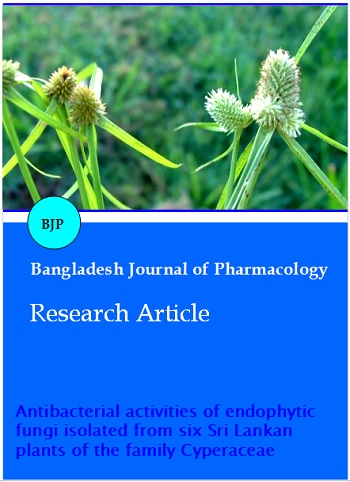Antibacterial activities of endophytic fungi isolated from six Sri Lankan plants of the family Cyperaceae
DOI:
https://doi.org/10.3329/bjp.v13i3.36716Keywords:
Antibacterial, Endophytic fungiAbstract
In a study designed to determine the antibacterial potential of endophytic fungi inhabiting plants of Cyperaceae family, 72 morphologically distinct endophytic fungi were isolated from six plants and their antibacterial activities against two Gram positive and three Gram negative pathogenic bacterial species were examined. Two antibacterial metabolites from two endophytes were also isolated and their chemical structures and minimum inhibitory concentrations were determined. Sixty six fungal extracts (92%) were active against at least one bacterium tested. Butyrolactone I isolated from the Aspergillus terreus and 9-epi viridol isolated from Trichoderma virens exhibited MIC values in the range 128-256 µg/mL against Gram positive Bacillus subtilits, Staphylococcus aureus, methicillin resistant S. aureus (MRSA) and Escherichia coli. Both compounds were inactive against other micro-organisms tested. This study confirmed that Cyperaceae plants harbor numerous endophytes that produce antibacterial metabolites active against both Gram positive and, to a lesser extent, Gram negative bacteria.
Video Clip of Methodology:
Column Chromatogrpahy: 15 min 34 sec Click to watch
Downloads
218
163 Read
73

Published
How to Cite
Issue
Section
License
Authors who publish with this journal agree to the following terms:
- Authors retain copyright and grant the journal right of first publication with the work simultaneously licensed under a Creative Commons Attribution License that allows others to share the work with an acknowledgement of the work's authorship and initial publication in this journal.
- Authors are able to enter into separate, additional contractual arrangements for the non-exclusive distribution of the journal's published version of the work (e.g., post it to an institutional repository or publish it in a book), with an acknowledgement of its initial publication in this journal.
- Authors are permitted and encouraged to post their work online (e.g., in institutional repositories or on their website) prior to and during the submission process, as it can lead to productive exchanges, as well as earlier and greater citation of published work (See The Effect of Open Access).
